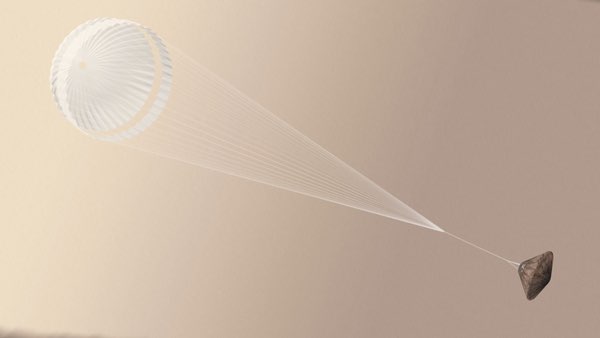Why ESA’s Schiaparelli Mars can still be considered an overall successby Svetoslav Alexandrov
|
| It’s easy to either downplay or exaggerate the module’s role, while it’s hard to estimate its true value. Many journalists have already gone into one of the two extremes. |
However the Trace Gas Orbiter didn’t go to Mars alone. Piggypacking on the orbiter was a small landing module called Schiaparelli. It separated from the mother craft three days before arrival and entered the atmosphere as expected. Unfortunately, seconds before the moment of touchdown, the signal from the craft abruptly stopped and was never regained.
In a situation like that, it’s easy to either downplay or exaggerate the module’s role, while it’s hard to estimate its true value. Many journalists have already gone into one of the two extremes. They either say that Schiaparelli is not at all important and it’s actually the orbiter that matters, or they focus too much on the fact that Schiaparelli never contacted the Earth after landing and are quick to dismiss the whole ExoMars 2016 mission as a failure.
In order to understand the worth of Schiaparelli, one must know what its original goals were and what ESA hoped to accomplish.
According to the official description by ESA, Schiaparelli was stated to be an “entry, descent and landing demonstration module.” It stated that “Schiaparelli will demonstrate the capability of ESA and European industry to perform a controlled landing on the surface of Mars,” as well as that “the preparation for this mission enhances Europe’s expertise and enables the testing of key technologies which could be used in subsequent missions to Mars.”
The science capabilities of Schiaparelli were described as “limited, but useful.” Schiaparelli was not equipped with solar panels or radioisotope thermoelectric generators, but instead relied solely on batteries and was only designed to function between two to eight days after landing. With this lander ESA never had the chance to beat the long-standing NASA’s rover missions. One of the most striking features about Schiaparelli people immediately noticed was that it lacked a panoramic camera, designed to take photos after landing. It only had a small descent camera that was scheduled to take 15 low-resolution images several kilometers above the ground. Many space enthusiasts felt underwhelmed by the choices ESA made concerning Schiaparelli’s design.
By keeping in mind that according to ESA Schiaparelli was, most importantly, simply a demonstrator, we start to understand its mission much better. Surely, gone is the planned surface phase of the mission with the limited science activities. This is disappointing, of course. We can’t deny it.
However, Schiaparelli sent a lot of data during its descent to Mars. It is estimated that the orbiter ExoMars 2016 recorded up to 600 megabytes of engineering information from the module. According to the preliminary information we have, the team even got scientific data about the vertical structure of the atmosphere as part of the AMELIA science experiment, which could still yield important discoveries. By doing this, we can’t object that Schiaparelli raised the bar very high in terms of how the landers should communicate on their way down to Mars surface. We ought to remind that some failed landers in the past like the Mars Polar Lander in 1999 and Beagle 2 in 2003 didn’t have a capability to send even simple beeps on their way to the surface, making it difficult to determine the exact causes of the failures.
| What matters, however, is the amount of data engineers have in their hands. They have a lot of time to fully analyze it and prepare for later missions. |
The demonstration went mostly according to plan. Many of the steps during the descent were executed successfully, like the parachute deployment and the heat shield separation. It was even reported that the radar started recording data and the engines fired. During the very late stages, though, something went awry and the engines were fired for 3 seconds rather than the expected 30 seconds, resulting in a hard impact. This was also confirmed by the images taken by Mars Reconnaissance Orbiter: the parachute is clearly visible, while the soil where Schiaparelli supposedly landed looks significantly disturbed. Mars is very unforgiving and simple mistakes rarely go unpunished.
What matters, however, is the amount of data engineers have in their hands. They have a lot of time to fully analyze it and prepare for later missions. This is why, despite the failed soft landing of the plucky Schiaparelli, ESA would probably still consider it at least as being partially successful. In fact, Jan Wörner, ESA director general, has already declared the overall 2016 Mars mission as 96 percent successful. “The importance of TGO and [Schiaparelli] can be described as 80% vs. 20%, respectively. Since we obtained at least 80% of the data during the descent, the overall success rate can be calculated as follows: 80+20*0.8 = 96%. All in all, a very positive result”, he has written on his blog.
In October next year, humanity will celebrate 60 years since the launch of Sputnik 1 and the beginning of the Space Age. During this period, 55 Mars missions were launched, but if we exclude the launch failures, only 16 went as far a to try to conduct Mars landings: Mars 2, Mars 3, Mars 6, Mars 7, Viking 1, Viking 2, Mars Pathfinder, Mars Polar Lander, Deep Space 2 Scott and Amundsen microprobes, Beagle 2, Spirit, Opportunity, Phoenix, Curiosity, and Schiaparelli. Few of these landers sent detailed data during their descent. Landing on Mars is hard, but in order to improve our odds, more experimental data needs to be collected. Schiaparelli may have narrowly missed its soft landing, but it still paves the way to future Mars missions.
